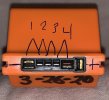Neither....... but I am not sure if I should just plug into each end or should the positive be on the one end and negative needs to go into each of the slots.
Each adjacent contact is a cell with a positive side and a negative side for THAT cell. The drawing has two lines leading from each cell number. Each line leads to either the positive or negative for that numbered cell. Each connection point (except the two on the ends) is the positive contact for one cell and the negative contact for the next. The drawing notes the negative on the left and the positive on the right. The final positive side has two contacts. One matches the connector in the OEM charger, the other matches the connector in the aircraft.
A 9v battery is probably too much for an individual cell and not enough for the whole battery pack. Getting "creative" and trying to charge two cells at a time with the 9v might get a little risky.
Many folks use a 5v USB charger with the plug cut off to charge one cell at a time until the overall pack has enough charge for the normal charger to start.



